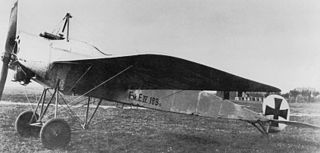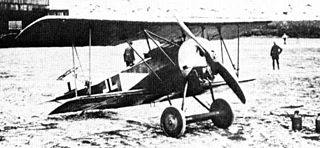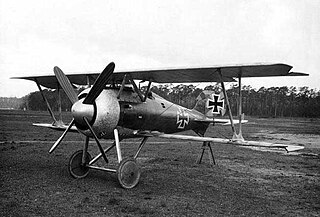
The Fokker Dr.I, often known simply as the Fokker Triplane, was a World War I fighter aircraft built by Fokker-Flugzeugwerke. The Dr.I saw widespread service in the spring of 1918. It became famous as the aircraft in which Manfred von Richthofen gained his last 17 victories, and in which he was killed on 21 April 1918.

The Fokker E.V was a German parasol-monoplane fighter aircraft designed by Reinhold Platz and built by Fokker-Flugzeugwerke. The E.V was the last Fokker design to become operational with the Luftstreitkräfte, entering service in the last months of World War I. After several fatal accidents due to wing failures, the aircraft was modified and redesignated Fokker D.VIII. Dubbed the Flying Razor by post-war pulp-fiction writers, the D.VIII had the distinction of scoring the last aerial victory of the war.

The Fokker Eindecker fighters were a series of German World War I monoplane single-seat fighter aircraft designed by Dutch engineer Anthony Fokker. Developed in April 1915, the first Eindecker ("Monoplane") was the first purpose-built German fighter aircraft and the first aircraft to be fitted with a synchronization gear, enabling the pilot to fire a machine gun through the arc of the propeller without striking the blades. The Eindecker gave the German Army's Air Service (then the Fliegertruppen des deutschen Kaiserreiches) a degree of air superiority from July 1915 until early 1916. This period, during which Allied aviators regarded their poorly armed aircraft as "Fokker Fodder", became known as the "Fokker Scourge".

The Fokker E.I was the first fighter aircraft to enter service with the Fliegertruppe of the Deutsches Heer in World War I. Its arrival at the front in mid-1915 marked the start of a period known as the "Fokker Scourge" during which the E.I and its successors achieved a measure of air superiority over the Western Front.

The Fokker E.II was the second variant of the German Fokker Eindecker single-seat monoplane fighter aircraft of World War I. The E.II was essentially a Fokker E.I with the 75 kW (100 hp) Oberursel U.I 9-cylinder rotary engine, a close copy of the French Gnôme Monosoupape rotary of the same power output, in place of the E.I's 60 kW (80 hp) Oberursel U.0, but whereas the E.I was simply a M.5K with a 7.92 mm (.312 in) machine gun bolted to it, the E.II was designed with the weapon system integrated with its airframe.

The Fokker E.III was the main variant of the Eindecker fighter aircraft of World War I. It entered service on the Western Front in December 1915 and was also supplied to Austria-Hungary and Turkey.

The Fokker E.IV was the final variant of the Eindecker fighter aircraft that was operated by Germany during World War I.

The Siemens-Schuckert D.IV was a late-World War I fighter aircraft from Siemens-Schuckert (SSW). It reached service too late and was produced in too few numbers to have any effect on the war effort.

The Albatros D.V is a fighter aircraft of the German aircraft manufacturer Albatros Flugzeugwerke. It was the final development of the Albatros D.I family and the last Albatros fighter to see operational service with the Luftstreitkräfte during the First World War.

The Pfalz D.VIII was a German World War I fighter aircraft.

The Fokker D.VI was a German fighter aircraft built in limited numbers at the end of World War I. The D.VI served in the German and Austro-Hungarian air services.

The Fokker M 10 was a two-seater reconnaissance / trainer biplane with single-bay wings equipped with wing-warping controls for roll, powered by a 7-cylinder 80 hp Oberursel U.0 engine. Several M 10 aircraft were purchased by the Imperial and Royal Aviation Troops of Austro Hungary.

The Fokker D.II was a German fighter biplane of World War I. It was a single-seat fighter aircraft developed before the Fokker D.I. It was based on the M.17 prototype, with single-bay unstaggered wings and a larger fuselage and shorter span than production D.IIs. Using a 75 kW (100 hp) Oberursel U.I, the D.II was underpowered, though the single 7.92 mm (.312 in) lMG 08 machine gun was normal for 1916. The German Army purchased 177.

The Fokker D.III was a German single-seat fighter aircraft of World War I. It saw limited frontline service before being withdrawn from combat in December 1916.

The Siemens-Schuckert D.III was a German single-seat fighter built by Siemens-Schuckert Werke. The D.III was a development of the earlier Siemens-Schuckert D.IIc prototype. The D.III was an (nearly) equal-span biplane powered by a 160 hp (119 kW) Siemens-Halske Sh.III bi-rotary engine. Idflieg placed an order for 20 aircraft in December 1917, followed by a second order of 30 aircraft in February 1918.
The Euler D.II was a German single-seat fighter, the successor to the earlier Euler D.I. The D.II was essentially a re-engined Euler D.I, the air-frame being virtually unchanged and the power plant being a 100 hp Oberusel U I 9-cylinder rotary.

The Morane-Saulnier H was an early aircraft first flown in France in the months immediately preceding the First World War; it was a single-seat derivative of the successful Morane-Saulnier G with a slightly reduced wingspan Like the Type G, it was a successful sporting and racing aircraft: examples serving with the French army were used in the opening phases of the war.
The Kondor E 3, sometimes erroneously known as E.III, was a German single seat, monoplane fighter aircraft designed and built close to the end of World War I. Though successful in the third D-type fighter competition at Aldershof in September 1918, only a few were produced, given the Idflieg designation of Kondor D.I.

The Sands Fokker Dr.1 Triplane is an American homebuilt aircraft that was designed by Ron Sands Sr of Mertztown, Pennsylvania, and produced by Wicks Aircraft and Motorsports. It is a full-sized replica fighter aircraft based upon the 1917-vintage Fokker Dr.1. The aircraft is supplied as a kit and in the form of plans for amateur construction.
The NFW E.I was a prototype fighter aircraft built in Germany during World War I.

















